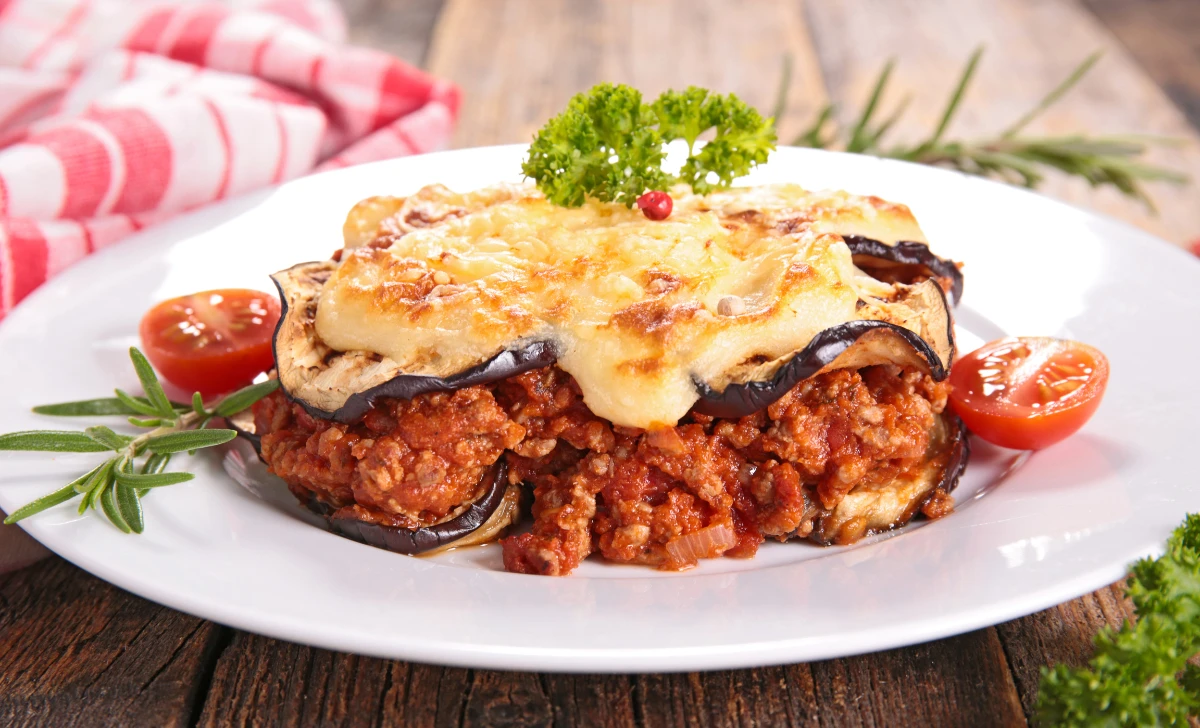Moussaka, a classic dish from the Mediterranean region, is a culinary masterpiece that boasts layers of rich flavors, hearty ingredients, and history. In this article, we will delve into the world of Moussaka, exploring its origin, various variations, and providing you with a detailed recipe to create this savory delight in your own kitchen.
[ez-toc]
History
The history of Moussaka is a fascinating journey through time and across cultures, primarily centered in the Mediterranean region. This beloved dish has a rich and diverse history that has shaped it into the culinary masterpiece it is today.
Moussaka’s roots can be traced back to the Ottoman Empire, where it is believed to have been influenced by a dish known as “musakka.” This original dish was characterized by a combination of sautéed vegetables and spiced meat, with the name “musakka” likely derived from the Arabic word “musaqqa,” which means chilled. It’s important to note that early versions of Moussaka were quite different from the Greek Moussaka we know and love today.
Over time, as culinary traditions evolved, the dish began to take on a distinct Greek identity. The Greek version of Moussaka became more established and is renowned for its layers of sautéed eggplant, spiced meat sauce, and a creamy béchamel topping. This transformation and adaptation are a testament to the influence of various cultures and culinary exchange that took place in the Mediterranean region.
Moussaka, as we know it today, has deep connections with Greek cuisine, and it has become an integral part of Greek culinary heritage. The Greek version has been popularized worldwide and is often considered a national dish, proudly served in homes and restaurants throughout Greece and beyond.
In Greece, Moussaka has not only remained a cherished family dish but has also become an iconic part of Greek culture. It is often served at celebrations, gatherings, and holidays, further solidifying its importance in the culinary landscape.
The dish’s popularity has transcended borders, and you can find various adaptations and versions of Moussaka in countries across the Mediterranean and beyond. For example, in Turkey, you might encounter a version called “musakka,” which often replaces eggplant with zucchini. Similarly, the Levantine cuisine offers its twist on Moussaka, known as “maghmour,” where chickpeas are used as the primary ingredient.
The history of Moussaka is not just about its evolution as a dish but also about the cultural exchange that has taken place over centuries. It’s a reminder of how culinary traditions can be a reflection of the diverse influences and interactions between different cultures. Moussaka continues to be a symbol of the rich and varied culinary heritage of the Mediterranean and serves as an invitation to explore the flavors and stories of this region.
Time
| Step | Time |
|---|---|
| Preparing the Eggplant | 20 minutes |
| Making the Meat Sauce | 30 minutes |
| Assembling the Layers | 15 minutes |
| Baking the Moussaka | 40 minutes |
| Cooling and Serving | 10 minutes |
Please note that these times are approximate and can vary based on your experience in the kitchen and the specific recipe you’re following. Additionally, some steps may overlap, and the total time can also depend on the efficiency of your preparation.
Ingredients
| Ingredients | Quantity for 2 Servings |
|---|---|
| Eggplant | 1 medium |
| Ground meat (lamb or beef) | 1/2 pound |
| Onions | 1 medium-sized |
| Garlic cloves | 2 cloves |
| Tomatoes (canned or fresh) | 2 large or equivalent |
| Tomato paste | 2 tablespoons |
| Red wine (optional) | 1/4 cup (optional) |
| Spices: cinnamon, allspice, nutmeg | To taste |
| Olive oil | 2-3 tablespoons |
| Flour | 2 tablespoons |
| Milk | 1 cup |
| Butter | 2 tablespoons |
| Grated cheese (Parmesan or Kefalotyri) | 1/2 cup (for topping) |
These quantities are tailored for a Moussaka recipe designed to serve two people. Adjust as needed for more servings or personal preferences.
Directions
Step 1: Preparing the Eggplant
1.1. Slice the Eggplant: Start by washing the eggplant and slicing it into thin rounds, about 1/4 inch thick.
1.2. Salting the Eggplant: Lay the eggplant slices on a flat surface and generously sprinkle them with salt. This helps draw out excess moisture and reduces bitterness. Allow the slices to sit for about 15-20 minutes.
1.3. Rinsing and Drying: After the resting period, rinse the eggplant slices under cold water and pat them dry with paper towels.
1.4. Frying the Eggplant: In a large skillet, heat some olive oil over medium-high heat. Fry the eggplant slices in batches until they turn golden brown on both sides. Place the fried slices on paper towels to remove excess oil. Set aside.
Step 2: Making the Meat Sauce
2.1. Sautéing Onions and Garlic: In the same skillet, add more olive oil if needed and sauté finely chopped onions and minced garlic until they become translucent and fragrant.
2.2. Adding Ground Meat: Add the ground meat (lamb or beef) to the skillet and cook until it browns and crumbles.
2.3. Incorporating Tomatoes: Stir in chopped tomatoes or canned tomatoes, and add tomato paste for extra richness and flavor.
2.4. Seasoning: Season the meat sauce with spices such as cinnamon, allspice, and nutmeg, according to your taste. You can also add a splash of red wine at this stage for an extra layer of flavor (optional).
2.5. Simmering: Allow the sauce to simmer over low heat until it thickens and the flavors meld together. This typically takes about 20-30 minutes.
Step 3: Assembling the Layers
3.1. Layering the Dish: In a baking dish, begin by placing a layer of the fried eggplant slices. Follow this with a layer of the meat sauce, creating a flavorful stack. Repeat this process until all the eggplant and meat sauce have been used.
Step 4: Baking and Serving
4.1. Béchamel Sauce: Prepare the béchamel sauce by melting butter in a saucepan, adding flour, and slowly whisking in milk until it thickens. Pour the béchamel sauce evenly over the top layer of the Moussaka.
4.2. Baking: Place the baking dish in a preheated oven at 350°F (175°C) and bake for about 40 minutes or until the top turns a beautiful golden brown.
4.3. Cooling and Serving: Allow the Moussaka to cool for about 10 minutes before serving. This resting period allows the flavors to meld together. Cut into squares and serve this delicious Greek classic to enjoy.
These steps will guide you through the process of preparing a delectable Moussaka, and they are sure to result in a dish that’s both flavorful and comforting.
Equipment Required
Nutrition Information
| Nutrition Information | Per Serving – Approximate |
|---|---|
| Serving Size | 1/4 of a standard 9×13-inch baking dish |
| Calories | 400-450 calories |
| Total Fat | 25-30 grams |
| Protein | 20-25 grams |
| Carbohydrates | 25-30 grams |
| Dietary Fiber | 4-6 grams |
| Sugars | 7-10 grams |
| Cholesterol | 60-70 mg |
| Sodium | 500-600 mg |
| Potassium | 700-800 mg |
Please note that these values are approximate and can vary based on specific ingredients and portion sizes. The nutritional content can also be adjusted to meet dietary preferences or restrictions, such as by using lean meat or meat substitutes, reducing fat content, or opting for low-sodium ingredients.
Tips
- Drain the Eggplant: Make sure to drain the excess moisture from the eggplant slices after salting them. This prevents the Moussaka from becoming watery during baking.
- Use Lean Meat: If you’re looking for a healthier option, opt for lean ground meat or even ground turkey. It will reduce the fat content while maintaining great flavor.
- Rest the Dish: After baking, allow the Moussaka to rest for about 10 minutes before serving. This resting period lets the flavors meld together and makes for easier slicing.
- Make Ahead: Moussaka is a dish that can be prepared in advance and reheated when needed. It often tastes even better the next day, as the flavors continue to develop.
- Alternate Vegetables: While eggplant is traditional, you can experiment with other vegetables like zucchini or potatoes for the layers, creating unique variations.
- Try Vegetarian Options: For a vegetarian twist, replace the meat with cooked lentils, mushrooms, or crumbled tofu. These alternatives are excellent sources of protein and add a delightful texture.
- Be Mindful of Spices: Be careful when adding spices like cinnamon, allspice, and nutmeg. Start with a small amount and taste as you go, as these spices can easily overwhelm the dish if used in excess.
- Use a Mandoline: To ensure uniformly thin eggplant slices, consider using a mandoline slicer. It will help you achieve even cooking.
- Choose the Right Cheese: The choice of cheese can vary. While Parmesan or Kefalotyri cheese is traditional, you can also experiment with other hard, salty cheeses like Pecorino Romano.
- Experiment with Herbs: Add fresh herbs like oregano, basil, or parsley to the meat sauce for an extra layer of flavor and freshness.
Pros & Cons
| Pros | Cons |
|---|---|
| ✅ Delicious and Flavorful | ❌ Time-Consuming |
| ✅ Versatile – Various Ingredients | ❌ High in Calories and Fat |
| ✅ Can Be Made in Advance | ❌ Requires Multiple Steps |
| ✅ Great for Leftovers | ❌ May Need Special Ingredients |
| ✅ Reflects Mediterranean Culture | ❌ Can Be Labor-Intensive |
Conclusion
In conclusion, Moussaka is a delectable journey through the rich flavors and cultural history of the Mediterranean. This classic dish, with its layers of sautéed eggplant, spiced meat sauce, and creamy béchamel topping, offers a taste of Greece that’s hard to resist.
While it may involve some time and effort in the kitchen, the end result is well worth it. The layers of flavors meld together to create a comforting and savory experience that’s perfect for a special occasion or a memorable family dinner.
Moussaka is versatile, allowing for various ingredient choices and adaptations to suit your dietary preferences. Whether you’re a meat lover, a vegetarian, or seeking a healthier twist, Moussaka can accommodate your needs.
So, why not embark on a culinary adventure and give Moussaka a try? It’s an opportunity to savor a dish with deep cultural roots and to create a meal that will leave a lasting impression. Don’t be daunted by the preparation; the journey is as rewarding as the destination. Your taste buds and dining companions will thank you for the effort. Enjoy your homemade Moussaka and the delightful flavors of the Mediterranean!
Facts
- Fact 1: 🌍 A Dish with Multinational Roots
- Did you know that Moussaka’s history is like a culinary passport? This iconic dish has Ottoman, Greek, and Arabic influences, and each version offers a unique twist. It’s a delicious testimony to the rich tapestry of Mediterranean cuisine.
- Fact 2: 🍆 The Secret to Perfect Eggplant
- The key to heavenly Moussaka lies in the eggplant. Why? It’s all about the slices. By salting, rinsing, and frying them to golden perfection, you create a mouthwatering layer of flavor and texture that’s simply irresistible.
- Fact 3: 🍷 A Dash of Mediterranean Magic
- Want to add a dash of Mediterranean magic to your Moussaka? Don’t skip the optional red wine in the meat sauce. It’s like a culinary sorcerer’s secret, enhancing the flavors and aroma of this classic dish.
- Fact 4: 🧀 A Cheese Fit for the Gods
- Kefalotyri cheese, often used as a topping, is a staple of Greek cuisine. It’s not just cheese; it’s a tribute to the gods. Similar to Parmesan, it elevates the flavor and authenticity of your Moussaka.
- Fact 5: 🕰️ Moussaka: A Dish from the Sands of Time
- Moussaka has been enchanting taste buds for centuries. Its roots can be traced back to the Ottoman Empire, making it a dish with a timeless legacy. The flavors of history are packed into each bite.
FAQ’s
Can I prepare Moussaka in advance and reheat it?
Yes, Moussaka can be made ahead of time and reheated. In fact, it often tastes even better the next day as the flavors continue to develop. Simply reheat it in the oven or microwave.
Is it possible to make a vegetarian version of Moussaka?
Absolutely. You can replace the meat with ingredients like lentils, mushrooms, or tofu to create a delicious vegetarian Moussaka.
What type of cheese works best for topping Moussaka?
Traditionally, Parmesan or Kefalotyri cheese is used, but you can also experiment with other hard, salty cheeses like Pecorino Romano.
Can I freeze Moussaka for later consumption?
Yes, you can freeze Moussaka. It’s advisable to slice it into portions before freezing for easier reheating. When ready to eat, thaw it in the refrigerator and then reheat in the oven.
What wine pairs well with Moussaka?
A red wine, such as a Greek Xinomavro or a Merlot, complements Moussaka nicely. It’s an excellent choice for enhancing the overall dining experience.
Is there a low-calorie version of Moussaka?
To reduce the calorie content, you can make a lighter béchamel sauce using low-fat milk and less butter, and use lean meat or meat substitutes.
What’s the best way to avoid a watery Moussaka?
To prevent excess moisture, make sure to drain the eggplant slices after salting them, and allow the Moussaka to rest after baking to let any excess liquid settle.
Can I add a spicy kick to my Moussaka?
Yes, you can add a pinch of cayenne pepper or red pepper flakes to the meat sauce to give your Moussaka a spicy twist.
Is there a way to make the preparation process faster and more convenient?
If you’re short on time, consider a simplified version of Moussaka using pre-made roasted eggplant slices and ground meat or meat substitute for a quick and easy meal.
What side dishes go well with Moussaka?
Moussaka pairs wonderfully with a Greek salad and warm pita bread. The fresh flavors of the salad and the warm bread complement the savory richness of the dish.












Leave a Review